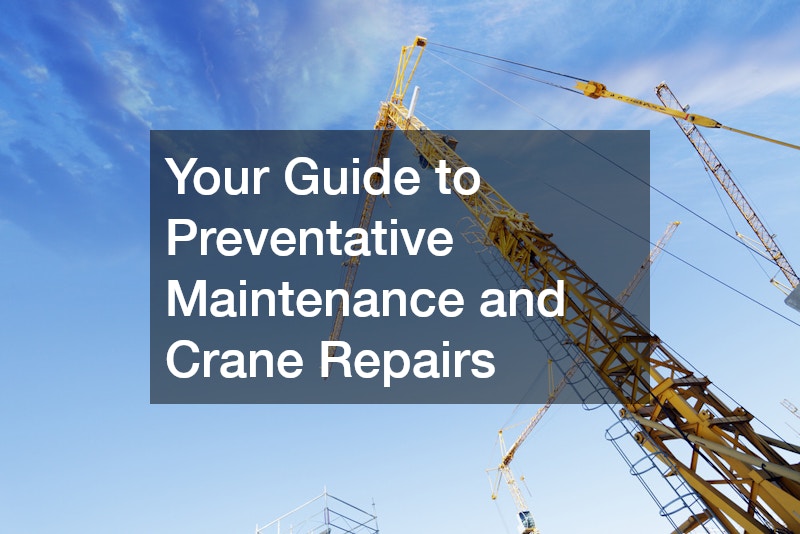Explore the essential practices for maintaining cranes to ensure their optimal performance and prolong their operational life. This guide will walk you through the importance of preventative maintenance and repair strategies for cranes. Effective maintenance and repair not only maximize your equipment’s productivity but also guarantee safety and compliance with industry regulations.
Understanding the Basics of Preventative Maintenance
Preventative maintenance involves regular and systematic inspections, servicing, and repairs of crane components to prevent unexpected failures. It encompasses activities such as lubrication, adjustment, cleaning, and replacement of parts.
By systematically identifying potential issues before they manifest into serious problems, preventative maintenance plays a crucial role in maintaining crane functionality.
Implementing a solid preventative maintenance plan starts with having a clear maintenance checklist tailored to the specific type of crane. Analysis of manufacturer guidelines and historical equipment data helps in crafting this checklist. Regularly updating the checklist ensures that it adapts to evolving operational demands and new regulatory requirements.
Ensuring Safety and Efficiency
Regular maintenance significantly enhances the safety of crane operations by detecting and rectifying potential hazards early. This diligence helps in preventing accidents that could result from equipment malfunctions, ensuring a secure workplace for operators and other personnel. Efficiently running cranes reduce the risk of incidents that could lead to injuries or even fatalities.
Efficiency in crane operations is synonymous with consistent performance and minimized downtime, both of which are achieved through proper maintenance. A well-maintained crane operates smoothly, leading to optimized job execution and timely project delivery. Also, routine maintenance minimizes the risk of sudden breakdowns, contributing to uninterrupted operations.
Cost-Effectiveness of Regular Maintenance
Preventative maintenance is a financially astute approach as it extends crane lifespan and reduces the need for unexpected repairs. By routinely investing in maintenance, unexpected breakdowns that require costly repairs can be effectively minimized. This translates into fewer disruptions, helping to maintain steady cash flow and financial predictability.
Budgeting for regular maintenance is far more cost-effective than addressing extensive repairs that arise from neglect. Scheduled maintenance allows for planned expenses, which can be more easily managed within financial planning frameworks. Moreover, identifying minor issues early through maintenance can prevent them from escalating into major repairs.
Routine Maintenance Scheduling
Maintenance schedules should be meticulously developed based on the type of crane and its operating conditions. Manufacturer recommendations typically serve as a good starting point, but adjustments are made based on usage intensity and environmental factors. Regular scheduling ensures that all necessary maintenance tasks are addressed at appropriate intervals.
Planning involves setting up periodic inspections at daily, weekly, monthly, and annual intervals to ensure comprehensive oversight. Establishing a detailed timetable aids in ensuring that no critical maintenance is overlooked, facilitating consistent upkeep of the crane. Having dedicated personnel or a maintenance team to oversee scheduling and tasks ensures accountability and thoroughness.
Signs Your Crane Needs Immediate Attention
Unexpected noises or changes in crane operation are common indicators that immediate maintenance is required. Problems such as hydraulic leaks, excessive vibration, or erratic hoisting movements necessitate a swift response to prevent further damage. Ignoring these signs can result in severe malfunctions or pose significant safety risks.
Operational inefficiencies including longer load cycles, difficulty in maneuvering, or reduced lifting capacity signal underlying issues. These might stem from worn-out parts or misalignments requiring prompt rectification. Regular operator feedback and performance tracking are important to catching these problems early.
Seasonal Maintenance Adjustments
Adapting maintenance strategies to suit different seasons ensures that environmental impacts are mitigated. For instance, winterization procedures are necessary in colder climates to protect cranes from freezing temperatures. Similarly, summer maintenance might involve checks for overheating and ensuring adequate lubrication.
The operating environment, such as exposure to saltwater or extreme temperatures, influences maintenance adjustments. Ensuring adequate rust protection in coastal areas minimizes corrosion, while implementing dust control measures is critical in arid regions. Season-specific maintenance minimizes wear and tear emerging from environmental conditions.
Identifying Common Crane Issues
Common crane malfunctions include issues with hoisting, electrical systems, hydraulic leaks, and brake failures. These can often result from regular wear and tear or neglecting routine maintenance requirements. Recognizing these issues early can prevent more extensive damage and operational disruption.
Regularly inspecting mechanical components such as ropes, pulleys, and hooks is essential as they frequently sustain damage. Hydraulic systems are vulnerable to leaks and pressure loss, necessitating proactive sealing and fluid replacement strategies. Electrical malfunctions typically arise from circuit disruptions, which require diagnostic testing and repairs.
Implementing Effective Repair Strategies
Effective crane repairs strategies involve precise diagnostics to pinpoint problems and determine the required actions. Utilizing specialized tools and equipment suited for crane maintenance is crucial in executing repairs efficiently. Training maintenance personnel on these tools elevates the repair process by ensuring correct application and methodology.
The Role of Professional Crane Technicians
Professional crane technicians possess specialized skills that are vital for tackling complex repair scenarios. Leveraging their expertise ensures that repairs are conducted per industry standards, minimizing risks. Engaging professionals allows operators to focus on operational duties while experts handle technical challenges.
By prioritizing preventative maintenance and timely repairs, crane operators can ensure the safety, efficiency, and longevity of their equipment. Consistent attention to maintenance and repair needs can prevent costly downtime and enhance overall performance. Implementing a holistic maintenance strategy guarantees optimal crane functionality, supporting successful and secure operations in diverse environments.


